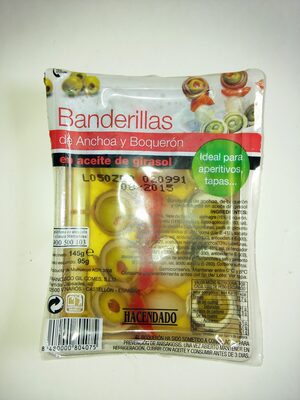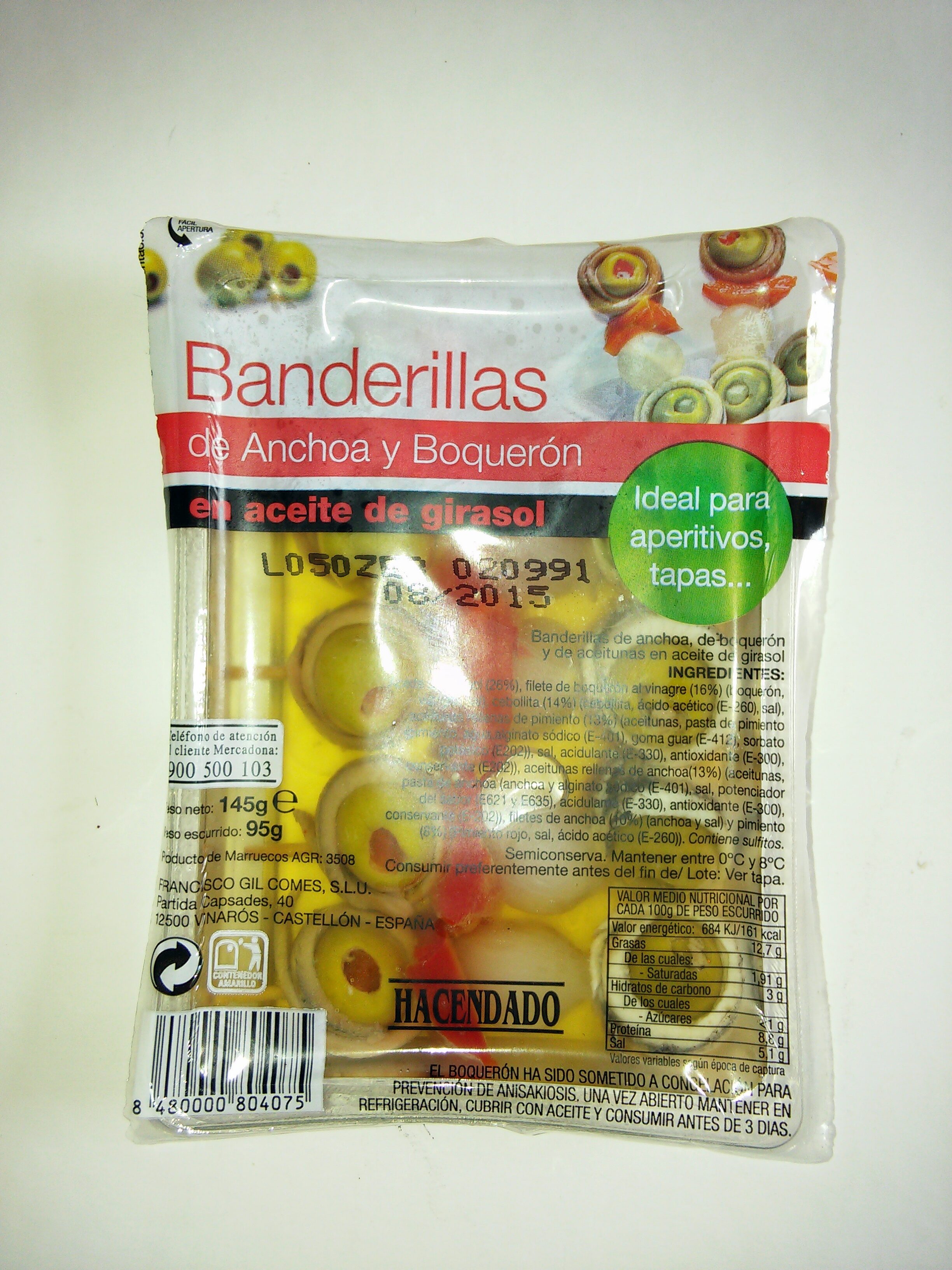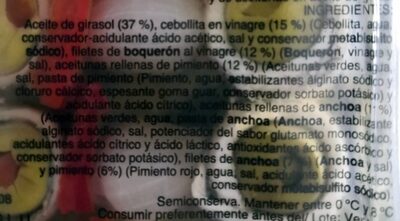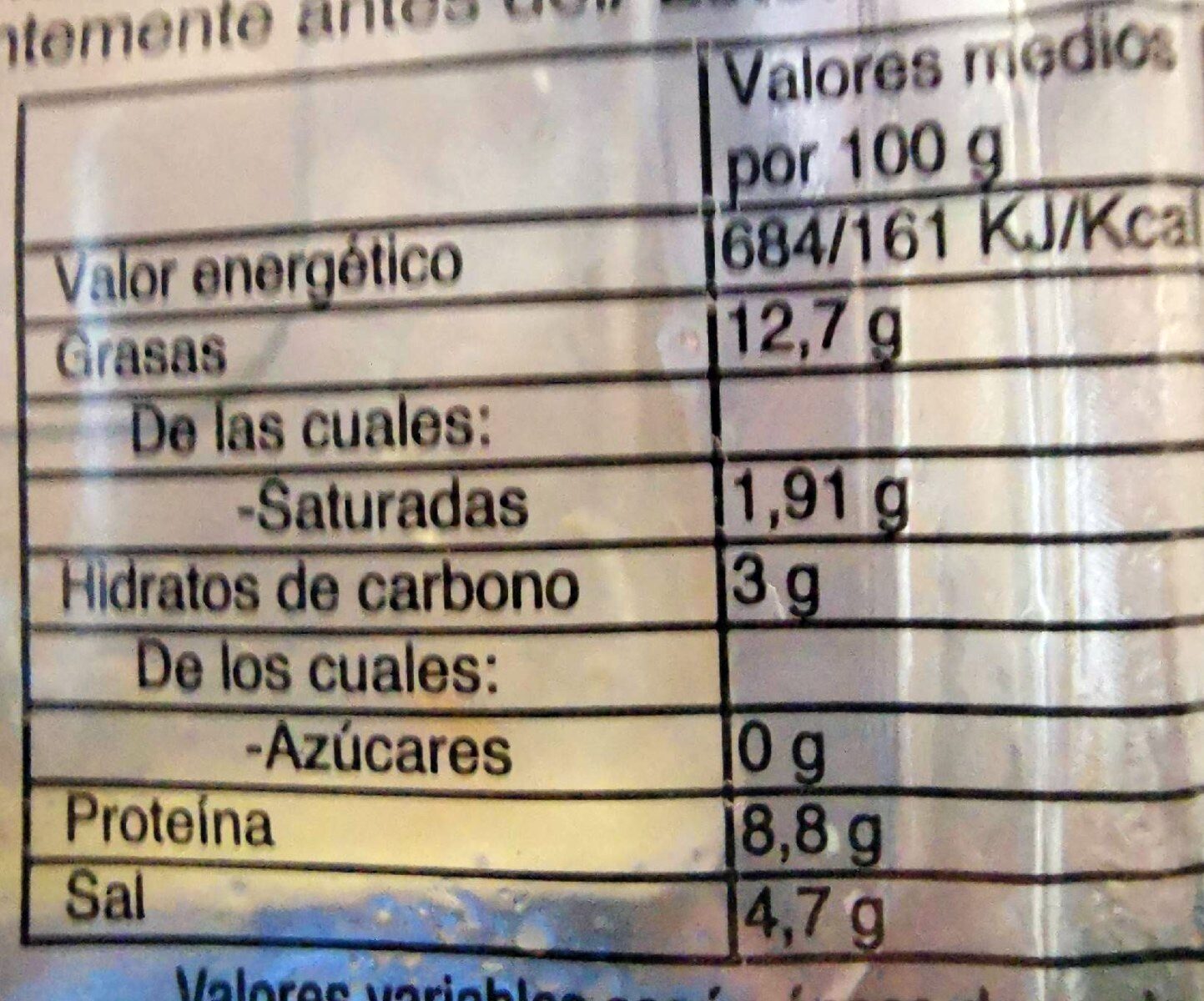Help us make food transparency the norm!
As a non-profit organization, we depend on your donations to continue informing consumers around the world about what they eat.
The food revolution starts with you!
Banderillas de anchoa y boquerón en aceite de girasol - Hacendado - 145 g
Banderillas de anchoa y boquerón en aceite de girasol - Hacendado - 145 g
This product page is not complete. You can help to complete it by editing it and adding more data from the photos we have, or by taking more photos using the app for Android or iPhone/iPad. Thank you!
×
Barra-kodea: 8480000804075 (EAN / EAN-13)
Izen arrunta: Banderillas de anchoa, de boquerón y de aceitunas en aceite de girasol
Kopurua: 145 g
Ontziratzea: es:Bandeja de plastico, es:Green dot
Markak: Hacendado
Kategoriak: en:Plant-based foods and beverages, en:Plant-based foods, en:Seafood, en:Fishes and their products, en:Fishes, en:Pickles, en:Plant-based pickles, en:Plant-based mixed pickles, en:Banderillas
Etiketak, ziurtagiriak, sariak:
en:Green Dot, en:With Sunflower oil
Origin of ingredients: Maroko
Dendak: Mercadona
Saltzen diren herrialdeak: Espainia
Matching with your preferences
Health
Osagaiak
-
57 ingredients
: Aceite de girasol 37%, cebollita en vinagre 15% (cebollita, agua, conservador-acidulante (ácido acético), sal, conservador (metabisulfito sódico)), filetes de boquerón al vinagre 12% (boquerón, vinagre, sal), aceitunas rellenas de pimiento 12% (aceitunas verdes, agua, sal, pasta de pimiento (pimiento, agua, estabilizantes (alginato sódico, cloruro cálcico), espesante (goma guar), conservador (sorbato potásico)), acidulante (ácido citrico)), aceitunas rellenas de anchoa 11% (aceitunas verdes, agua, pasta de anchoa (anchoa, estabilizante (alginato sódico), sal, potenciador del sabor (glutamato monosódico), acidulantes (ácido citrico, ácido láctico), antioxidantes (ácido ascórbico), conservador (sorbato potásico)), filetes de anchoa 7% (anchoa, sal), pimiento 6% (pimiento rojo, agua, sal, acidulante (ácido acético), conservador (metabisulfito sódico)).Alergenoak: en:Fish, en:Sulphur dioxide and sulphites, es:anchoa, es:boqueron, es:metabisulfito-sodico
Food processing
-
Ultra processed foods
Elements that indicate the product is in the 4 - Ultra prozesatutako elikagaiak eta edariak group:
- Gehigarria: E401
- Gehigarria: E412
- Gehigarria: E621
- Osagaia: Flavour enhancer
- Osagaia: Thickener
Food products are classified into 4 groups according to their degree of processing:
- Prozesatu gabeko edo ahalik eta gutxien prozesatutako elikagaiak
- Sukaldaritzako osagaiak prozesatu
- Prozesatutako jakiak
- Ultra processed foods
The determination of the group is based on the category of the product and on the ingredients it contains.
Gehigarriak
-
E202
Potassium sorbate: Potassium sorbate is the potassium salt of sorbic acid, chemical formula CH3CH=CH−CH=CH−CO2K. It is a white salt that is very soluble in water -58.2% at 20 °C-. It is primarily used as a food preservative -E number 202-. Potassium sorbate is effective in a variety of applications including food, wine, and personal-care products. While sorbic acid is naturally occurring in some berries, virtually all of the world's production of sorbic acid, from which potassium sorbate is derived, is manufactured synthetically.Source: Wikipedia (Ingeles)
-
E223
Sodium metabisulfite: Sodium metabisulfite or sodium pyrosulfite -IUPAC spelling; Br. E. sodium metabisulphite or sodium pyrosulphite- is an inorganic compound of chemical formula Na2S2O5. The substance is sometimes referred to as disodium metabisulfite. It is used as a disinfectant, antioxidant, and preservative agent.Source: Wikipedia (Ingeles)
-
E260 - Azido azetiko
Acetic acid: Acetic acid , systematically named ethanoic acid , is a colorless liquid organic compound with the chemical formula CH3COOH -also written as CH3CO2H or C2H4O2-. When undiluted, it is sometimes called glacial acetic acid. Vinegar is no less than 4% acetic acid by volume, making acetic acid the main component of vinegar apart from water. Acetic acid has a distinctive sour taste and pungent smell. In addition to household vinegar, it is mainly produced as a precursor to polyvinyl acetate and cellulose acetate. It is classified as a weak acid since it only partially dissociates in solution, but concentrated acetic acid is corrosive and can attack the skin. Acetic acid is the second simplest carboxylic acid -after formic acid-. It consists of a methyl group attached to a carboxyl group. It is an important chemical reagent and industrial chemical, used primarily in the production of cellulose acetate for photographic film, polyvinyl acetate for wood glue, and synthetic fibres and fabrics. In households, diluted acetic acid is often used in descaling agents. In the food industry, acetic acid is controlled by the food additive code E260 as an acidity regulator and as a condiment. In biochemistry, the acetyl group, derived from acetic acid, is fundamental to all forms of life. When bound to coenzyme A, it is central to the metabolism of carbohydrates and fats. The global demand for acetic acid is about 6.5 million metric tons per year -Mt/a-, of which approximately 1.5 Mt/a is met by recycling; the remainder is manufactured from methanol. Vinegar is mostly dilute acetic acid, often produced by fermentation and subsequent oxidation of ethanol.Source: Wikipedia (Ingeles)
-
E270
Lactic acid: Lactic acid is an organic compound with the formula CH3CH-OH-COOH. In its solid state, it is white and water-soluble. In its liquid state, it is colorless. It is produced both naturally and synthetically. With a hydroxyl group adjacent to the carboxyl group, lactic acid is classified as an alpha-hydroxy acid -AHA-. In the form of its conjugate base called lactate, it plays a role in several biochemical processes. In solution, it can ionize a proton from the carboxyl group, producing the lactate ion CH3CH-OH-CO−2. Compared to acetic acid, its pKa is 1 unit less, meaning lactic acid deprotonates ten times more easily than acetic acid does. This higher acidity is the consequence of the intramolecular hydrogen bonding between the α-hydroxyl and the carboxylate group. Lactic acid is chiral, consisting of two optical isomers. One is known as L--+--lactic acid or -S--lactic acid and the other, its mirror image, is D--−--lactic acid or -R--lactic acid. A mixture of the two in equal amounts is called DL-lactic acid, or racemic lactic acid. Lactic acid is hygroscopic. DL-lactic acid is miscible with water and with ethanol above its melting point which is around 17 or 18 °C. D-lactic acid and L-lactic acid have a higher melting point. In animals, L-lactate is constantly produced from pyruvate via the enzyme lactate dehydrogenase -LDH- in a process of fermentation during normal metabolism and exercise. It does not increase in concentration until the rate of lactate production exceeds the rate of lactate removal, which is governed by a number of factors, including monocarboxylate transporters, concentration and isoform of LDH, and oxidative capacity of tissues. The concentration of blood lactate is usually 1–2 mM at rest, but can rise to over 20 mM during intense exertion and as high as 25 mM afterward. In addition to other biological roles, L-lactic acid is the primary endogenous agonist of hydroxycarboxylic acid receptor 1 -HCA1-, which is a Gi/o-coupled G protein-coupled receptor -GPCR-.In industry, lactic acid fermentation is performed by lactic acid bacteria, which convert simple carbohydrates such as glucose, sucrose, or galactose to lactic acid. These bacteria can also grow in the mouth; the acid they produce is responsible for the tooth decay known as caries. In medicine, lactate is one of the main components of lactated Ringer's solution and Hartmann's solution. These intravenous fluids consist of sodium and potassium cations along with lactate and chloride anions in solution with distilled water, generally in concentrations isotonic with human blood. It is most commonly used for fluid resuscitation after blood loss due to trauma, surgery, or burns.Source: Wikipedia (Ingeles)
-
E330 - Azido zitriko
Citric acid: Citric acid is a weak organic acid that has the chemical formula C6H8O7. It occurs naturally in citrus fruits. In biochemistry, it is an intermediate in the citric acid cycle, which occurs in the metabolism of all aerobic organisms. More than a million tons of citric acid are manufactured every year. It is used widely as an acidifier, as a flavoring and chelating agent.A citrate is a derivative of citric acid; that is, the salts, esters, and the polyatomic anion found in solution. An example of the former, a salt is trisodium citrate; an ester is triethyl citrate. When part of a salt, the formula of the citrate ion is written as C6H5O3−7 or C3H5O-COO-3−3.Source: Wikipedia (Ingeles)
-
E412
Guar gum: Guar gum, also called guaran, is a galactomannan polysaccharide extracted from guar beans that has thickening and stabilizing properties useful in the food, feed and industrial applications. The guar seeds are mechanically dehusked, hydrated, milled and screened according to application. It is typically produced as a free-flowing, off-white powder.Source: Wikipedia (Ingeles)
-
E621
Monosodium glutamate: Monosodium glutamate -MSG, also known as sodium glutamate- is the sodium salt of glutamic acid, one of the most abundant naturally occurring non-essential amino acids. Glutamic acid is found naturally in tomatoes, grapes, cheese, mushrooms and other foods.MSG is used in the food industry as a flavor enhancer with an umami taste that intensifies the meaty, savory flavor of food, as naturally occurring glutamate does in foods such as stews and meat soups. It was first prepared in 1908 by Japanese biochemist Kikunae Ikeda, who was trying to isolate and duplicate the savory taste of kombu, an edible seaweed used as a base for many Japanese soups. MSG as a flavor enhancer balances, blends, and rounds the perception of other tastes.The U.S. Food and Drug Administration has given MSG its generally recognized as safe -GRAS- designation. A popular belief is that large doses of MSG can cause headaches and other feelings of discomfort, known as "Chinese restaurant syndrome," but double-blind tests fail to find evidence of such a reaction. The European Union classifies it as a food additive permitted in certain foods and subject to quantitative limits. MSG has the HS code 29224220 and the E number E621.Source: Wikipedia (Ingeles)
Ingredients analysis
-
en:Palm oil content unknown
Unrecognized ingredients: es:conservador-acidulante, es:filetes-de-boqueron-al-vinagre, es:aceitunas-rellenas-de-pimiento, es:pasta-de-pimiento, es:aceitunas-rellenas-de-anchoaSome ingredients could not be recognized.
We need your help!
You can help us recognize more ingredients and better analyze the list of ingredients for this product and others:
- Edit this product page to correct spelling mistakes in the ingredients list, and/or to remove ingredients in other languages and sentences that are not related to the ingredients.
- Add new entries, synonyms or translations to our multilingual lists of ingredients, ingredient processing methods, and labels.
If you would like to help, join the #ingredients channel on our Slack discussion space and/or learn about ingredients analysis on our wiki. Thank you!
-
en:Non-vegan
Non-vegan ingredients: en:European anchovy, en:Anchovy paste, en:Anchovy, en:Anchovy filets, en:AnchovySome ingredients could not be recognized.
We need your help!
You can help us recognize more ingredients and better analyze the list of ingredients for this product and others:
- Edit this product page to correct spelling mistakes in the ingredients list, and/or to remove ingredients in other languages and sentences that are not related to the ingredients.
- Add new entries, synonyms or translations to our multilingual lists of ingredients, ingredient processing methods, and labels.
If you would like to help, join the #ingredients channel on our Slack discussion space and/or learn about ingredients analysis on our wiki. Thank you!
-
en:Non-vegetarian
Non-vegetarian ingredients: en:European anchovy, en:Anchovy paste, en:Anchovy, en:Anchovy filets, en:AnchovySome ingredients could not be recognized.
We need your help!
You can help us recognize more ingredients and better analyze the list of ingredients for this product and others:
- Edit this product page to correct spelling mistakes in the ingredients list, and/or to remove ingredients in other languages and sentences that are not related to the ingredients.
- Add new entries, synonyms or translations to our multilingual lists of ingredients, ingredient processing methods, and labels.
If you would like to help, join the #ingredients channel on our Slack discussion space and/or learn about ingredients analysis on our wiki. Thank you!
-
Details of the analysis of the ingredients
We need your help!
Some ingredients could not be recognized.
We need your help!
You can help us recognize more ingredients and better analyze the list of ingredients for this product and others:
- Edit this product page to correct spelling mistakes in the ingredients list, and/or to remove ingredients in other languages and sentences that are not related to the ingredients.
- Add new entries, synonyms or translations to our multilingual lists of ingredients, ingredient processing methods, and labels.
If you would like to help, join the #ingredients channel on our Slack discussion space and/or learn about ingredients analysis on our wiki. Thank you!
: Aceite de girasol 37%, cebollita 15% (cebollita, agua, conservador-acidulante (ácido acético), sal, conservador (_metabisulfito sódico_)), filetes de _boquerón_ al vinagre 12% (_boquerón_, vinagre, sal), aceitunas rellenas de pimiento 12%, aceitunas verdes, agua, sal, pasta de pimiento (pimiento, agua, estabilizantes (alginato sódico, cloruro cálcico), espesante (goma guar), conservador (sorbato potásico)), acidulante (ácido citrico), aceitunas rellenas de anchoa 11%, aceitunas verdes, agua, pasta de _anchoa_ (_anchoa_, estabilizante (alginato sódico), sal, potenciador del sabor (glutamato monosódico), acidulantes (ácido citrico, ácido láctico), antioxidantes (ácido ascórbico), conservador (sorbato potásico)), filetes de _anchoa_ 7% (_anchoa_, sal), pimiento 6% (pimiento rojo, agua, sal, acidulante (ácido acético), conservador (_metabisulfito sódico_))- Aceite de girasol -> en:sunflower-oil - vegan: yes - vegetarian: yes - from_palm_oil: no - ciqual_food_code: 17440 - percent: 37
- cebollita -> en:small-white-onions - vegan: yes - vegetarian: yes - ciqual_food_code: 20034 - percent: 15
- cebollita -> en:small-white-onions - vegan: yes - vegetarian: yes - ciqual_food_code: 20034
- agua -> en:water - vegan: yes - vegetarian: yes - ciqual_food_code: 18066
- conservador-acidulante -> es:conservador-acidulante
- ácido acético -> en:e260 - vegan: yes - vegetarian: yes
- sal -> en:salt - vegan: yes - vegetarian: yes - ciqual_food_code: 11058
- conservador -> en:preservative
- _metabisulfito sódico_ -> en:e223 - vegan: yes - vegetarian: yes
- filetes de _boquerón_ al vinagre -> es:filetes-de-boqueron-al-vinagre - percent: 12
- _boquerón_ -> en:european-anchovy - vegan: no - vegetarian: no - ciqual_food_code: 26079
- vinagre -> en:vinegar - vegan: yes - vegetarian: yes - ciqual_food_code: 11018
- sal -> en:salt - vegan: yes - vegetarian: yes - ciqual_food_code: 11058
- aceitunas rellenas de pimiento -> es:aceitunas-rellenas-de-pimiento - percent: 12
- aceitunas verdes -> en:green-olive - vegan: yes - vegetarian: yes - ciqual_food_code: 13033
- agua -> en:water - vegan: yes - vegetarian: yes - ciqual_food_code: 18066
- sal -> en:salt - vegan: yes - vegetarian: yes - ciqual_food_code: 11058
- pasta de pimiento -> es:pasta-de-pimiento
- pimiento -> en:bell-pepper - vegan: yes - vegetarian: yes - ciqual_food_code: 20041
- agua -> en:water - vegan: yes - vegetarian: yes - ciqual_food_code: 18066
- estabilizantes -> en:stabiliser
- alginato sódico -> en:e401 - vegan: yes - vegetarian: yes
- cloruro cálcico -> en:e509 - vegan: yes - vegetarian: yes
- espesante -> en:thickener
- goma guar -> en:e412 - vegan: yes - vegetarian: yes
- conservador -> en:preservative
- sorbato potásico -> en:e202 - vegan: yes - vegetarian: yes
- acidulante -> en:acid
- ácido citrico -> en:e330 - vegan: yes - vegetarian: yes
- aceitunas rellenas de anchoa -> es:aceitunas-rellenas-de-anchoa - percent: 11
- aceitunas verdes -> en:green-olive - vegan: yes - vegetarian: yes - ciqual_food_code: 13033
- agua -> en:water - vegan: yes - vegetarian: yes - ciqual_food_code: 18066
- pasta de _anchoa_ -> en:anchovy-paste - vegan: no - vegetarian: no - ciqual_food_code: 26079
- _anchoa_ -> en:anchovy - vegan: no - vegetarian: no - ciqual_food_code: 26079
- estabilizante -> en:stabiliser
- alginato sódico -> en:e401 - vegan: yes - vegetarian: yes
- sal -> en:salt - vegan: yes - vegetarian: yes - ciqual_food_code: 11058
- potenciador del sabor -> en:flavour-enhancer
- glutamato monosódico -> en:e621 - vegan: yes - vegetarian: yes
- acidulantes -> en:acid
- ácido citrico -> en:e330 - vegan: yes - vegetarian: yes
- ácido láctico -> en:e270 - vegan: yes - vegetarian: yes
- antioxidantes -> en:antioxidant
- ácido ascórbico -> en:e300 - vegan: yes - vegetarian: yes
- conservador -> en:preservative
- sorbato potásico -> en:e202 - vegan: yes - vegetarian: yes
- filetes de _anchoa_ -> en:anchovy-filets - vegan: no - vegetarian: no - ciqual_food_code: 26079 - percent: 7
- _anchoa_ -> en:anchovy - vegan: no - vegetarian: no - ciqual_food_code: 26079
- sal -> en:salt - vegan: yes - vegetarian: yes - ciqual_food_code: 11058
- pimiento -> en:bell-pepper - vegan: yes - vegetarian: yes - ciqual_food_code: 20041 - percent: 6
- pimiento rojo -> en:red-bell-pepper - vegan: yes - vegetarian: yes - ciqual_food_code: 20087
- agua -> en:water - vegan: yes - vegetarian: yes - ciqual_food_code: 18066
- sal -> en:salt - vegan: yes - vegetarian: yes - ciqual_food_code: 11058
- acidulante -> en:acid
- ácido acético -> en:e260 - vegan: yes - vegetarian: yes
- conservador -> en:preservative
- _metabisulfito sódico_ -> en:e223 - vegan: yes - vegetarian: yes
Elikadura
-
Poor nutritional quality
⚠ ️Abisua: zuntz kopurua ez dago zehaztuta, ezin izan dute kontuan izan kalifikaziorako izan dezaketen ekarpen positiboa.⚠ ️Warning: the amount of fruits, vegetables and nuts is not specified on the label, it was estimated from the list of ingredients: 33This product is not considered a beverage for the calculation of the Nutri-Score.
Positive points: 0
- Proteinak: 5 / 5 (balioa: 8.8, rounded value: 8.8)
- Fiber: 0 / 5 (balioa: 0, rounded value: 0)
- Fruits, vegetables, nuts, and colza/walnut/olive oils: 0 / 5 (balioa: 33.75, rounded value: 33.8)
Negative points: 13
- Energia: 2 / 10 (balioa: 684, rounded value: 684)
- Azukreak: 0 / 10 (balioa: 0, rounded value: 0)
- Gantz saturatua: 1 / 10 (balioa: 1.91, rounded value: 1.9)
- Sodioa: 10 / 10 (balioa: 1880, rounded value: 1880)
The points for proteins are not counted because the negative points are greater or equal to 11.
Nutritional score: (13 - 0)
Nutri-Score:
-
Nutrient levels
-
Koipe in moderate quantity (12.7%)
What you need to know- A high consumption of fat, especially saturated fats, can raise cholesterol, which increases the risk of heart diseases.
Recommendation: Limit the consumption of fat and saturated fat- Choose products with lower fat and saturated fat content.
-
Gantz-azido ase in moderate quantity (1.91%)
What you need to know- A high consumption of fat, especially saturated fats, can raise cholesterol, which increases the risk of heart diseases.
Recommendation: Limit the consumption of fat and saturated fat- Choose products with lower fat and saturated fat content.
-
Azukre in low quantity (0%)
What you need to know- A high consumption of sugar can cause weight gain and tooth decay. It also augments the risk of type 2 diabetes and cardio-vascular diseases.
Recommendation: Limit the consumption of sugar and sugary drinks- Sugary drinks (such as sodas, fruit beverages, and fruit juices and nectars) should be limited as much as possible (no more than 1 glass a day).
- Choose products with lower sugar content and reduce the consumption of products with added sugars.
-
Gatz arrunt in high quantity (4.7%)
What you need to know- A high consumption of salt (or sodium) can cause raised blood pressure, which can increase the risk of heart disease and stroke.
- Many people who have high blood pressure do not know it, as there are often no symptoms.
- Most people consume too much salt (on average 9 to 12 grams per day), around twice the recommended maximum level of intake.
Recommendation: Limit the consumption of salt and salted food- Reduce the quantity of salt used when cooking, and don't salt again at the table.
- Limit the consumption of salty snacks and choose products with lower salt content.
-
-
Nutrition facts
Nutrition facts As sold
for 100 g / 100 mlCompared to: en:Banderillas Energia 684 kj
(161 kcal)+% 180 Koipe 12,7 g +% 257 Gantz-azido ase 1,91 g +% 158 Carbohydrates 3 g +% 59 Azukre 0 g -% 100 Fiber ? Proteina 8,8 g +% 415 Gatz arrunt 4,7 g +% 63 Fruits‚ vegetables‚ nuts and rapeseed‚ walnut and olive oils (estimate from ingredients list analysis) 33,75 %
Ingurumena
-
Eco-Score not computed - Unknown environmental impact
We could not compute the Eco-Score of this product as it is missing some data, could you help complete it?Could you add a precise product category so that we can compute the Eco-Score? Add a category
Ontziratzea
-
Packaging with a medium impact
-
Packaging parts
(Plastic)
-
Bilgarriaren materialak
Material % Bilgarriaren pisua Bilgarriaren pisua produktuaren 100g-ko Plastic
-
Transportation
-
Origins of ingredients
Origins of ingredients with a medium impact
Origin of the product and/or its ingredients % of ingredients Impact Maroko 100 %Medium
Report a problem
-
Incomplete or incorrect information?
Category, labels, ingredients, allergens, nutritional information, photos etc.
If the information does not match the information on the packaging, please complete or correct it. Open Food Facts is a collaborative database, and every contribution is useful for all.
Datuen iturria
Product added on by malikele
Last edit of product page on by packbot.
Produktuaren orria -gatik editatua acuario, alia, kiliweb, musarana, org-app-elcoco, yuka.ZjZrZ0NmZ3Z1T0FEdVBNZjR6TEp3ZlZINEoyRUFEN3BBck1MSWc9PQ.











